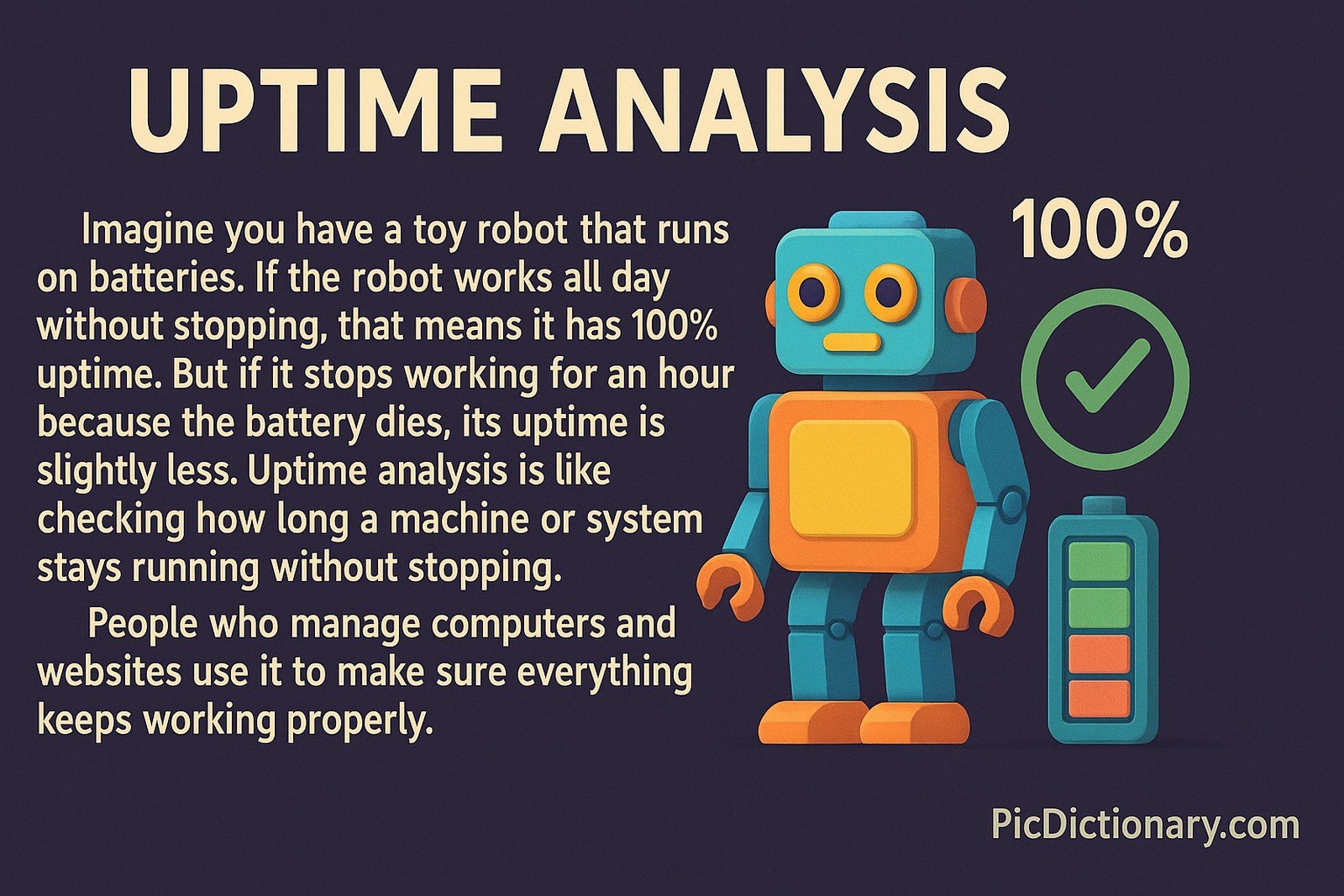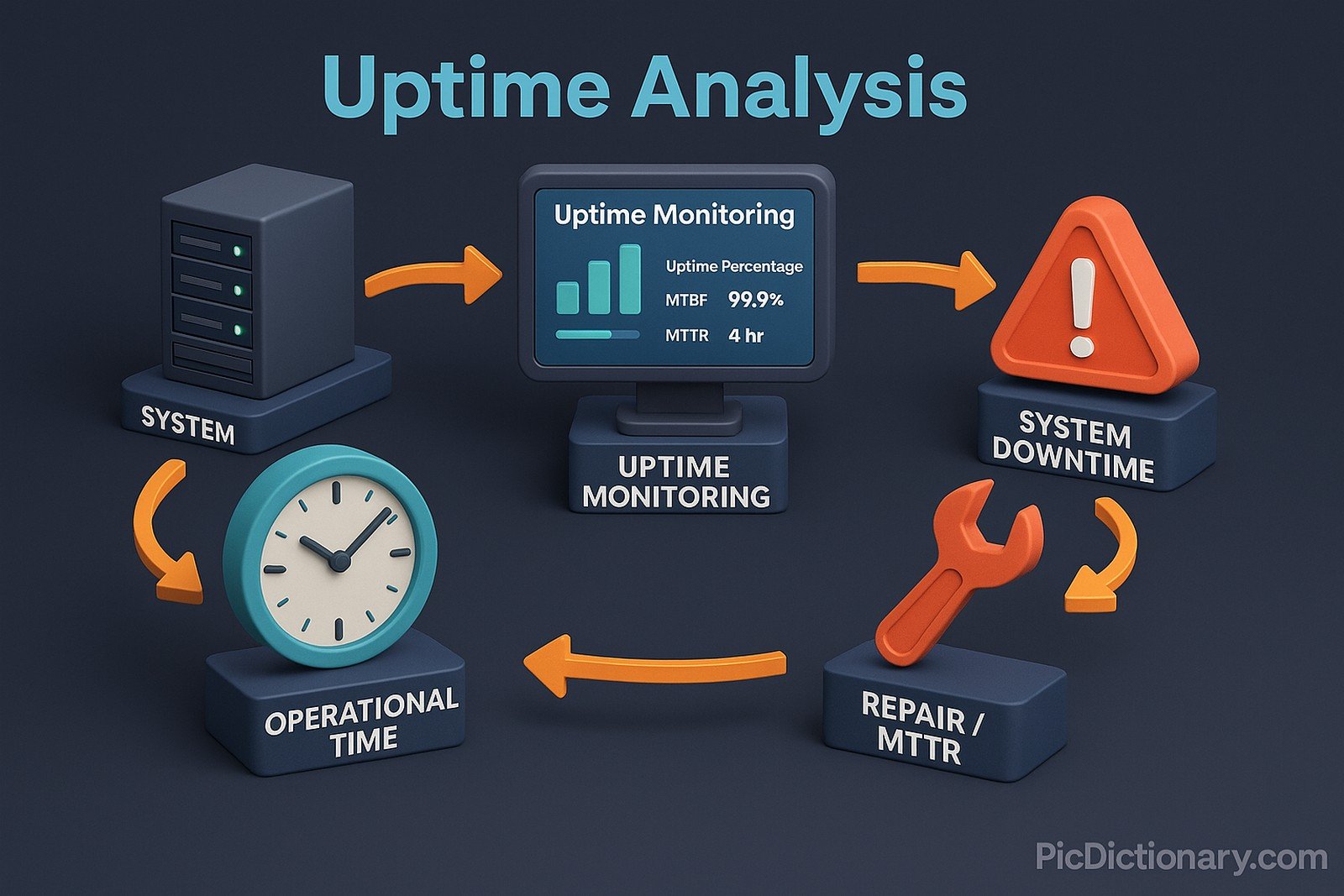Uptime Analysis
 (Representational Image | Source: Dall-E)
(Representational Image | Source: Dall-E)
Quick Navigation:
- Uptime Analysis Definition
- Uptime Analysis Explained Easy
- Uptime Analysis Origin
- Uptime Analysis Etymology
- Uptime Analysis Usage Trends
- Uptime Analysis Usage
- Uptime Analysis Examples in Context
- Uptime Analysis FAQ
- Uptime Analysis Related Words
Uptime Analysis Definition
Uptime analysis refers to the process of measuring and evaluating the operational status of a system, network, or application over a given period. It helps determine reliability, performance consistency, and system availability by tracking the percentage of time a system remains functional without failures. Uptime analysis is widely used in IT infrastructure management, cloud computing, and cybersecurity to ensure high service availability. Key metrics include uptime percentage, mean time between failures (MTBF), and mean time to repair (MTTR).
Uptime Analysis Explained Easy
Imagine you have a toy robot that runs on batteries. If the robot works all day without stopping, that means it has 100% uptime. But if it stops working for an hour because the battery dies, its uptime is slightly less. Uptime analysis is like checking how long a machine or system stays running without stopping. People who manage computers and websites use it to make sure everything keeps working properly.
Uptime Analysis Origin
The concept of uptime analysis emerged with the rise of computing infrastructure in the late 20th century, particularly as organizations began relying on large-scale networks and data centers. As businesses moved towards digital operations, ensuring continuous system uptime became a crucial requirement, leading to the development of monitoring tools and uptime tracking methodologies.
Uptime Analysis Etymology
The term “uptime” is derived from “up,” indicating a system being active, and “time,” referring to the duration of its availability. “Analysis” comes from the Greek word “analusis,” meaning "a breaking up" or detailed examination.
Uptime Analysis Usage Trends
With the growing dependence on digital infrastructure, uptime analysis has gained importance in IT service management, cloud computing, and e-commerce. Organizations emphasize uptime guarantees through Service Level Agreements (SLAs), ensuring reliability for customers. The demand for real-time monitoring tools, AI-driven predictive maintenance, and automated fault detection has driven significant advancements in uptime analysis techniques.
Uptime Analysis Usage
- Formal/Technical Tagging:
- IT Operations
- Cloud Computing
- Service Reliability - Typical Collocations:
- "99.99% uptime guarantee"
- "real-time uptime analysis"
- "uptime vs. downtime"
- "automated uptime monitoring"
Uptime Analysis Examples in Context
- A web hosting company conducts uptime analysis to ensure its servers maintain a 99.99% availability rate.
- Cloud service providers use uptime analysis to track system performance and avoid unexpected downtimes.
- Businesses rely on uptime analysis to meet SLA commitments and avoid penalties for service interruptions.
Uptime Analysis FAQ
- What is uptime analysis?
Uptime analysis is the evaluation of system availability and reliability over a specific period. - Why is uptime analysis important?
It helps organizations ensure continuous service, minimize downtime, and meet service level agreements (SLAs). - What is considered a good uptime percentage?
Typically, 99.9% uptime (referred to as "three nines") or higher is considered good for critical services. - How is uptime percentage calculated?
It is calculated using the formula: (Total Operational Time / Total Time) × 100%. - What are common tools for uptime analysis?
Tools like Pingdom, Datadog, and UptimeRobot monitor and analyze system uptime. - How does downtime affect businesses?
Unplanned downtime can lead to revenue loss, customer dissatisfaction, and SLA violations. - What is the difference between uptime and availability?
Uptime refers to the total operational time, while availability considers planned maintenance as well. - What industries use uptime analysis?
Industries like cloud computing, telecommunications, and e-commerce rely on uptime analysis. - What role does AI play in uptime analysis?
AI helps predict failures and optimize system performance before issues occur. - Can 100% uptime be achieved?
In theory, no system can guarantee absolute 100% uptime, but redundancy and failover strategies help maximize it.

Uptime Analysis Related Words
- Categories/Topics:
- System Monitoring
- IT Infrastructure
- Service Level Agreements
Did you know?
In 2013, Amazon’s cloud service experienced a 49-minute outage, resulting in an estimated revenue loss of $4.8 million. This event highlighted the crucial role of uptime analysis in preventing financial losses for online businesses.
PicDictionary.com is an online dictionary in pictures. If you have questions or suggestions, please reach out to us on WhatsApp or Twitter.Authors | Arjun Vishnu | @ArjunAndVishnu

I am Vishnu. I like AI, Linux, Single Board Computers, and Cloud Computing. I create the web & video content, and I also write for popular websites.
My younger brother, Arjun handles image & video editing. Together, we run a YouTube Channel that's focused on reviewing gadgets and explaining technology.



Comments powered by CComment